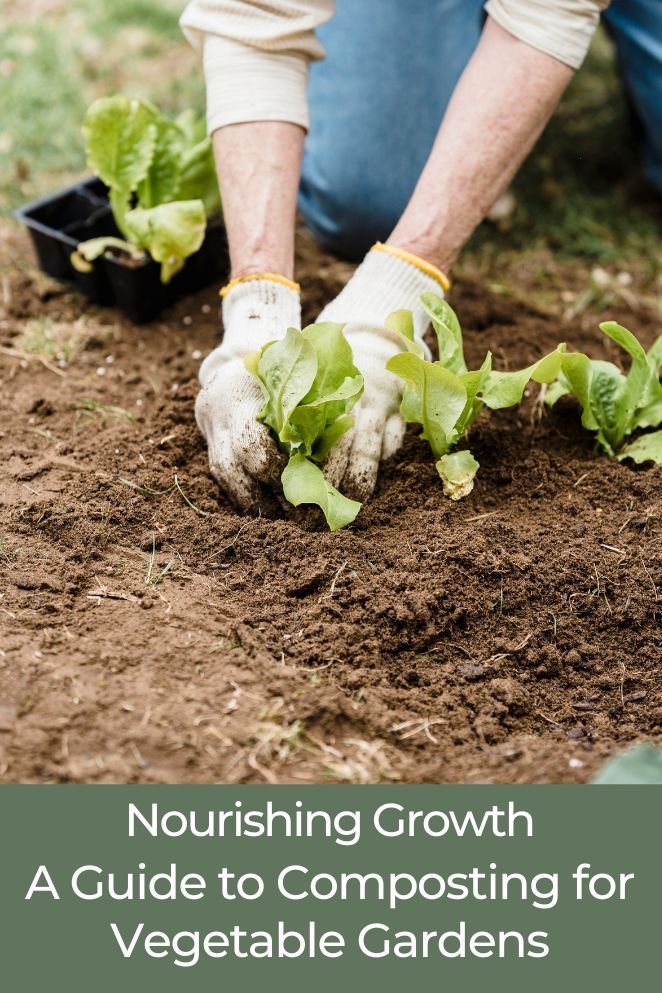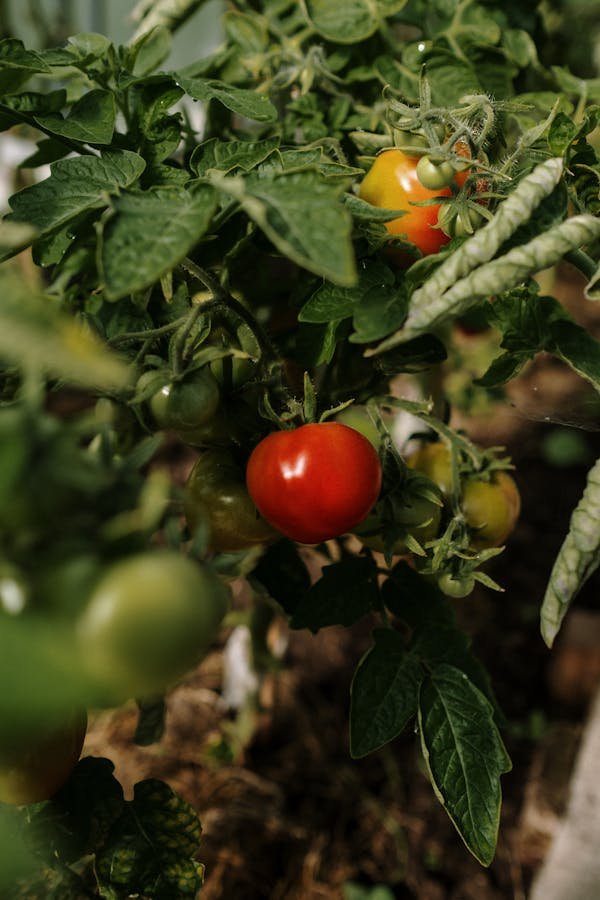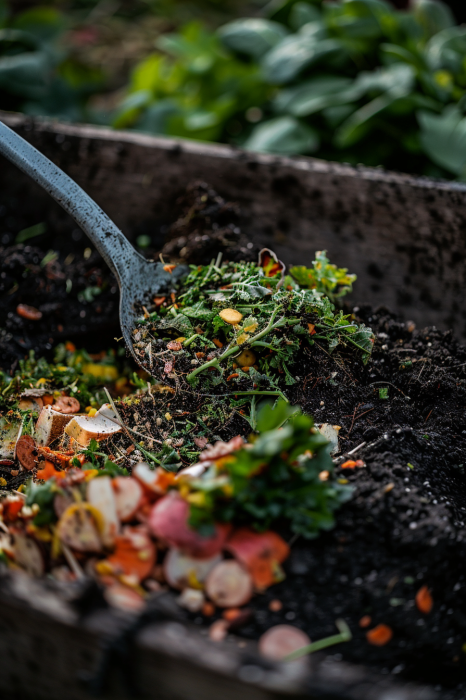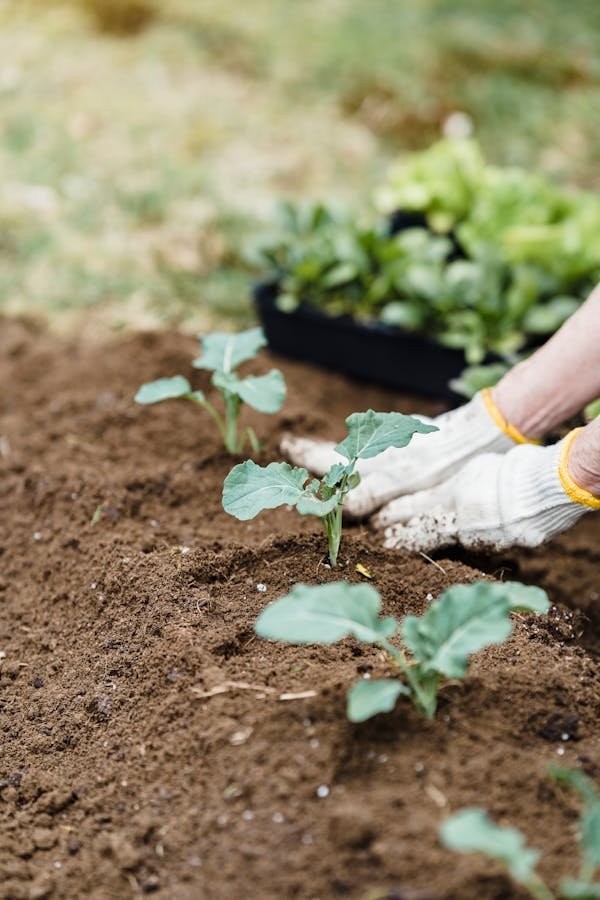
Hold onto your gardening gloves because today, we’re diving deep into the wonderful world of composting for vegetable gardens.
It’s like magic for your plants, and I’m here to spill all the secrets.
What is Compost
Compost is a mixture of organic materials that is decomposed by microorganisms to create a nutrient-rich soil amendment.
It is made from a variety of materials, including food scraps, yard waste, and other organic matter.
The process of composting involves creating an environment where microorganisms, such as bacteria and fungi, can break down the organic matter into a humus-like substance.
This process enriches the soil and can be used to improve plant growth and reduce the need for chemical fertilizers.
Composting is a sustainable way to recycle organic waste and has environmental benefits such as reducing greenhouse gas emissions and improving soil health.
It can be done at home using a variety of methods, including backyard composting, vermicomposting (worm composting), and using industrial-scale composting facilities.
- Read also: A Comprehensive Guide: Inorganic vs Organic Fertilizers
- Read also: DIY Guide: Homemade Compost for Growing Broccoli
Benefits of Adding Compost to Vegetable Gardens
Amending your vegetable garden with compost offers a multitude of benefits for your plants and the overall health of your soil.
Here’s some advantages:
Soil structure improvement
When you add compost to your garden beds, it works wonders on the structure of your soil.
It helps loosen heavy clay soils, making them easier for plant roots to penetrate.
On the flip side, it also helps sandy soils retain moisture and nutrients, preventing them from washing away.
Nutrient-rich boost
Compost, it’s like a nutrient-packed superfood for your plants, supplying them with a smorgasbord of essential nutrients like nitrogen, phosphorus, and potassium.
These nutrients are the building blocks of healthy growth, leading to bigger, tastier veggies come harvest time.
Moisture retention
Compost acts like a sponge, soaking up excess moisture during rainy spells and releasing it slowly during dry periods.
This helps keep your plants consistently hydrated, reducing the risk of wilting and stress.
Plus, it means less watering for you—talk about a win-win!
Weed suppression
By adding a layer of compost to your garden beds, you create a barrier that suppresses weed growth.
Plus, when your plants are healthy and thriving thanks to all that compost goodness, they’re better equipped to outcompete any pesky invaders that do manage to sprout up.
Disease prevention
Healthy soil equals healthy plants, and compost is the key to achieving both.
By enriching your soil with compost, you create an environment that’s teeming with beneficial microorganisms.
These microscopic allies help ward off harmful pathogens that can cause diseases in your plants.

Ingredients for Your Compost Bin
Composting is all about creating a balanced environment for decomposition.
To achieve this, you’ll need to add a mix of “brown” and “green” materials to your compost pile.
Brown materials (carbon rich)
Provide a source of carbon energy for the decomposing organisms.
Typically drier and break down slower. Examples of brown materials:
- Dry leaves
- Shredded cardboard (avoid glossy or colored cardboard)
- Twigs and branches (chopped into small pieces)
- Straw
- Sawdust (use sparingly as it decomposes slowly)
- Wood chips (use sparingly as it decomposes slowly)
- Paper towels and toilet paper rolls (shredded)
Green materials (nitrogen rich)
Provide nitrogen, which is essential for the growth of beneficial microbes that break down the compost pile. Typically wetter and decompose faster.
Examples of brown materials:
- Kitchen scraps (fruit and vegetable peels, eggshells, coffee grounds)
- Grass clippings (in moderation, avoid using too much)
- Tea bags
- Plant trimmings (not diseased)
- Manure (herbivore only, aged or composted)
Browns and greens ratio
A good rule of thumb is to aim for a ratio of 3 parts brown materials to 1 part green materials.
This ratio can vary depending on the specific materials you’re using, but it’s a good starting point to ensure your compost pile has the right balance of carbon and nitrogen for optimal decomposition.

What Materials to Keep Out of Your Compost
Some materials can do more harm than good, leading to contamination and potential harm to your plants.
Let’s take a closer look at what to keep out of your compost bin:
Synthetic materials
This includes things like plastic bags, Styrofoam packaging, and synthetic fabrics.
These materials don’t break down in the composting process and can end up lingering in your compost pile for years, causing pollution and disrupting the natural cycle of decomposition.
Treated wood
Treated wood is often treated with chemicals like arsenic, chromium, and copper, which can leach into your compost and harm your plants.
Stick to untreated wood or, better yet, find alternative ways to reuse or recycle treated wood scraps.
Glossy or colored paper
While newspaper and cardboard are compost-friendly, glossy or colored papers are often treated with chemicals or dyes that can contaminate your compost and harm your plants.
Stick to plain, unprinted paper products to keep your compost clean and healthy.
Diseased plants
Diseased plants can harbor pathogens and fungi that can survive the composting process and infect your garden when you spread the finished compost.
It’s best to dispose of diseased plant material in the trash or burn it to prevent the spread of disease.
Meat and dairy products
Meat, dairy, and oily foods should be kept out of your compost pile, as they can attract pests and create unpleasant odors.
Plus, they can take much longer to break down, disrupting the balance of your compost pile and delaying the composting process.
Chemicals, Paints, and oils
These substances can contain harmful toxins that not only disrupt the delicate balance of your compost but also pose risks to your plants and the environment.
Coal ash and cigarette butts
Coal ash can contain heavy metals and other harmful substances that can contaminate your compost and harm your plants.
Cigarette butts, on the other hand, can introduce nicotine and other chemicals that are toxic to plants and soil organisms.
Pet waste
Pet waste can harbor harmful pathogens like E. coli and salmonella, which can survive the composting process and pose risks to human health.
Instead, dispose of pet waste in the trash or use specialized composting systems designed specifically for pet waste disposal.
Glass and metal
Not only do they take forever to break down, but they can also pose safety hazards and contaminate your compost.
How to Make Compost for a Vegetable Garden
There are two main composting methods: aerobic and anaerobic methods. Here’s a quick table summarizing the key differences:
| Feature | Aerobic Composting |
Anaerobic Composting
|
| Oxygen Requirement | High | Low/None |
| Decomposition Speed | Faster (weeks-months) |
Slower (up to a year)
|
| Temperature | Heats Up |
Low Temperature
|
| Compost Quality | High (pathogen-free) |
Lower (may contain pathogens & weed seeds)
|
| Odor | Minimal | Can be odorous |
| Ideal for Home Use | Yes | No |
Aerobic method

This is the most common method for home composting and ideal for beginners.
Aerobic composting is the champion for home gardens due to its speed, efficiency, and minimal odor.
Aerobic composting needs oxygen to accelerate decomposition.
Aerobic bacteria are the key players here, thriving in an environment with plenty of oxygen.
Air circulation allows the pile to heat up significantly, accelerating decomposition (weeks to months).
This method produces high-quality compost free of pathogens and weed seeds, thanks to the high temperatures. It also generates minimal odor.
Here’s how to make aerobic compost:
Instruction
Step 1
Bin or pile: Choose a well-aerated container (compost bin) or designate a spot in your yard for an open pile.
Step 2
Layer it up: Start with a brown material base (4-6 inches) and add green materials on top, aiming for a 3:1 ratio of browns to greens. Chop or shred larger pieces for faster decomposition.
Step 3
Moisture magic: Keep the pile moist but not soggy, like a wrung-out sponge. Add water if dry, and brown materials if too wet.
Step 4
Aerobic action: Oxygen is vital! Turn the pile every few weeks with a shovel or pitchfork to aerate it. Alternatively, use a tumbling composter for easier mixing.
Step 5
Hot stuff: The pile will naturally heat up as decomposition accelerates. This heat helps kill weed seeds and pathogens.
Anaerobic method

While not as popular for small-scale composting, anaerobic methods have their uses in larger-scale operations.
Anaerobic composting happens in the absence of oxygen, often in sealed containers or pits. Decomposition is slower (up to a year) due to the lack of oxygen-loving bacteria.
Lower temperatures can lead to pathogens and weed seeds surviving.
Additionally, anaerobic digestion produces methane, a greenhouse gas.
The potential for odor and lower quality compost make this method less suitable for home composting. Here’s how to make anaerobic compost:
Instruction
Step 1
Dig a Hole: Choose a location away from your house and water sources. Dig a pit large enough for your organic waste.
Step 2
Layer away: Layer your browns and greens (no need for specific ratios), similar to an aerobic pile.
Step 3
Seal it up: Cover the pit tightly with a tarp or other material to exclude oxygen.
When is Compost Ready to Use
Depending on factors like temperature, moisture and method, your compost could take anywhere from a few months to a year to fully decompose.
Here are some general indicators to know when compost is ready:
Rich, dark brown color
Finished compost should resemble dark brown earth or topsoil.
Crumbly texture
It should crumble easily in your hand, not clump together in large chunks.
No recognizable materials
You shouldn’t see any large pieces of the original organic materials you added to the pile.
Earthy smell
The finished product should have a pleasant, earthy smell, like fresh forest soil.
Size reduction
The compost pile will have shrunk significantly, typically by about half its original size.
Plant germination test
Plant a few seeds in the compost and see if they germinate and grow into healthy plants. If 3/4 or more of the seeds sprout and grow, the compost is ready for use

Timing Compost for Vegetable Gardens
Adding compost to vegetable gardens is beneficial for improving soil structure, fertility, and overall plant health.
The best time to add compost depends on various factors such as your gardening goals, climate, and the specific needs of your vegetables.
Here are some considerations for timing compost applications:
Fall or spring
Fall and spring are generally the best times to add compost to vegetable gardens.
- In the fall, adding compost allows it to break down over the winter, enriching the soil for spring planting.
- In the spring, applying compost before planting provides nutrients for the growing season.
Before planting
Incorporate compost into the soil before planting your vegetables.
Mixing compost into the soil helps improve soil structure, drainage, and nutrient availability for young plants.
During planting
Mix compost into individual planting holes or rows when transplanting seedlings or sowing seeds.
This provides immediate access to nutrients for young plants as they establish roots.
As a top dressing
Apply compost as a top dressing around established plants during the growing season.
This helps replenish nutrients in the soil and provides a slow-release source of organic matter.
Avoid extreme weather
Avoid adding compost during periods of extreme heat, cold, or drought.
Extreme conditions can stress plants and disrupt microbial activity in the soil, affecting the composting process.

How to Apply Compost for Vegetable Gardens
New beds
For new vegetable beds, add a generous 3-4 inches of compost and mix it thoroughly into the top 8-12 inches of soil.
This provides a long-term nutrient base for your plants.
Existing beds
For established beds, refresh the soil with a lighter touch. Add a ¼ to 1-inch layer of compost annually in spring or fall.
You can also top dress around existing plants throughout the growing season with a thin layer (½ inch) of compost.
This provides a readily available nutrient source and helps retain moisture.
- Read also: DIY Plant Food for Vegetables
- Read also: DIY Plant Food Recipes for Indoor Plants
Conclusion
And there you have it, folks!
Composting for vegetable gardens demystified. It’s easy, it’s eco-friendly, and best of all, it’s incredibly rewarding.
So go ahead, give composting a try, and watch your garden flourish like never before.
FAQs
Absolutely! Citrus peels and onion scraps are both great additions to your compost pile. Just be sure to chop them up into smaller pieces to help them break down faster.
Ideally, you’ll want to turn your compost pile every 1-2 weeks to aerate it and speed up the decomposition process. But don’t stress if you can’t stick to a strict schedule—composting is forgiving!
Absolutely! Compost makes excellent mulch for your garden beds. Just be sure to wait until it’s fully decomposed before spreading it around your plants to avoid nitrogen leaching.



